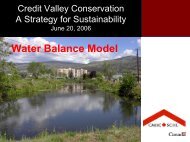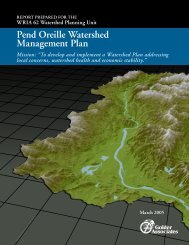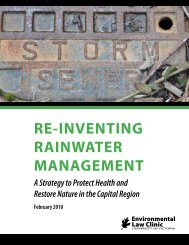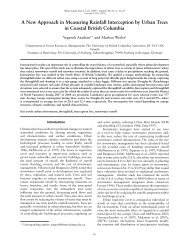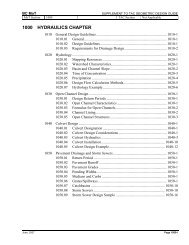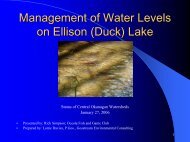Stormwater Source Control Design Guidelines 2005 - Waterbucket
Stormwater Source Control Design Guidelines 2005 - Waterbucket
Stormwater Source Control Design Guidelines 2005 - Waterbucket
Create successful ePaper yourself
Turn your PDF publications into a flip-book with our unique Google optimized e-Paper software.
<strong>Stormwater</strong> <strong>Source</strong> <strong>Control</strong> <strong>Design</strong> <strong>Guidelines</strong> <strong>2005</strong><strong>Design</strong>, Construction and Maintenance ProcessIn soils with very low infiltration rates – less than 1 mm/hr.,such as compact till –infiltration still occurs. An infiltration rateof 1mm/hour is 24mm/day, which would absorb a significantportion of annual rainfall. However, when rainfall is relativelycontinuous in winter months, the reservoir in these designs mayremain full between rain events, with rainfall-runoff movingdirectly to drainflow through the subdrain. To provideadditional storage, and a controlled release rate, a flowcontrol structure can be added to the subdrain. The smallorifice on the flow control structure provides a gradualdecanting of the storage above the drain pipe. In this sense,the technique operates like a miniature detention pond.However, the path of the rainfall-runoff through the soilmedium provides excellent filtration and water qualityimprovement.Strategies to Deal with Limited SpaceLand is a significant cost in the GVRD. A key advantage ofintegrating <strong>Stormwater</strong> <strong>Source</strong> <strong>Control</strong>s into the overall designof a project is to avoid requirements for additional land.Strategies to minimize the requirement for extra land forstormwater source control are listed in the <strong>Source</strong> <strong>Control</strong>Strategies for Limited Space Checklist.Greater Vancouver Sewerage & Drainage District103



